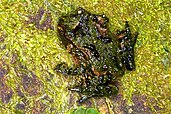The biodiversity of New Zealand is one of the most unusual on Earth, due to its long geological isolation from other continental landmasses. Its genetic affinities are derived from Gondwana, from which it separated 82 million years (Ma) ago, along with Australia, New Caledonia and Lord Howe Island, part of the same tectonic plate.
New Zealand's pre-human biodiversity exhibited high levels of endemism in its flora and fauna. The range of ancient fauna is not well-known but at least one species of non-flying terrestrial mammal existed in New Zealand around 19 Ma ago. Prior to 65 Ma ago, the fauna included dinosaurs, pterosaurs and marine reptiles.
For at least several Ma before the arrival of humans and their commensal species, the islands had no terrestrial mammals except for bats, the main component of the terrestrial fauna being insects and birds. Its flora is dominated by Gondwanan plants, comprising historically of forests, most famously the giant kauri, Agathis australis.
New Zealand has developed a national Biodiversity Action Plan to address conservation of considerable numbers of threatened flora and fauna within New Zealand. (Full article...)
